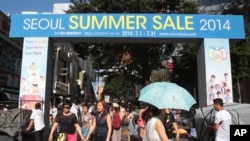South Korea unveiled a $40 billion stimulus package Thursday as the finance minister warned of a risk of recession after Asia's fourth-largest economy grew at its slowest rate for more than a year in the second quarter.
Citing sluggish domestic demand in the wake of a devastating ferry disaster in April, the finance ministry cut its forecast for economic expansion in 2014 to 3.7 from 4.1 percent.
The finance ministry's plans included additional spending of 11.7 trillion won ($11.4 billion) from the fiscal and quasi-fiscal accounts, 26 trillion won of loans or other financial support and easing in mortgage borrowing restrictions.
The central bank separately unveiled a plan to create a 3 trillion won lending facility, based on which banks can lend up to 12 trillion won with low interest rates to support corporate investment in production facilities within the country.
The lion's share will be spent in the remainder of this year, with 3.0 trillion won earmarked for the beginning of 2015, the ministry said in a statement.
All-out efforts
President Park Geun-hye has called for all-out efforts to boost the economy and Finance Minister Choi Kyung-hwan promised to take massive action, which investors believe will pressure the central bank to cut interest rates as soon as next month.
“The government's will to improve the economy is quite strong and there is a social understanding right now that the economy has to be supported. I feel that the measures will work,” said Kim Jong-su, economist at Taurus Investment & Securities.
“In the past, the government would focus its strength on one policy or another, but right now it is pulling in everything from all possible points.”
South Korea, which relies heavily on exports, has been dragged down by a slower-than-expected recovery in global demand, while domestic consumption has been fragile, partly as a result of the ferry sinking that hurt tourism and services.
South Korea's economy grew 0.6 percent in the April-June period over the prior quarter, data showed earlier on Thursday, the slowest growth since the first quarter of 2013, missing market expectations by about 0.7 percent.
The Bank of Korea data showed private consumption fell a seasonally adjusted 0.3 percent in the second quarter after edging up 0.2 percent in the January-March period. Capital investment rose 1.3 percent after a 1.9 percent decline.
It was the worst fall in private consumption since the third quarter of 2011 and only the second quarterly loss since then.
Ferry accident
The Sewol ferry sank on April 16, killing more than 300 people in the country's worst maritime accident in two decades. That led to massive cancelations of tour contracts across the country, badly affecting all businesses serving tourists.
Private consumption generates about half of South Korea's gross domestic product but the economy still relies heavily on exporters as their performance has a strong influence on jobs and investment within the country.
The latest growth data likely boost expectation that the Bank of Korea will cut its key interest rate as soon as next month. The bank has kept its benchmark interest rate at 2.5 percent since May, 2013.
Some information for this report provided by Reuters, AFP and AP.








